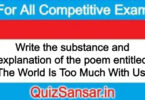
Give a brief Life-Sketch of PERCY BYSSHE SHELLEY.
Give a brief Life-Sketch of PERCY BYSSHE SHELLEY.
Ans.
PERCY BYSSHE SHELLEY (1792-1822)
His Birth and Parentage: Percy Bysshe Shelley (1792-1822) was born on August 4, 1792, at Field Place, near Horsham, Sussex, England. The eldest son of Timothy and Elizabeth Shelley, with one brother and four sisters, he stood in line to inherit not only his grandfather’s considerable estate but also a seat in Parliament. His father was a member of the House of Commons. The family line could be traced back to one of the followers of William of Normandy. Thus, in noble blood Shelley was more fortunate than most of his brother poets, considering the estimate that England placed upon the distinction of caste. He had all the advantages of wealth and rank, and hence much was expected of him.
His Education and Expulsion from the University: At the age of ten Shelley was placed in the public school of Sion House, but the harsh treatment of instructors and school-fellows rendered his life most unpleasant. Such treatment might have been called out by his fondness for wild romances and his devotion to reading instead of more solid school work. While very young he wrote two novels, ‘Zastrozzi’ and ‘St. Irvyne’, or the Rosicrucian’, works of some merit. Shelley was next sent to Eton, where his sensitive nature was again deeply wounded by ill usage. He finally revolted against all authority, and this disposition manifested itself strongly in Eton. Shelley then went to Oxford, but he studied irregularly, except in his peculiar views, where he seemed to be constant in his thought and speculations. At the age of fifteen, he wrote two short romances, threw off various political effusions, and published a volume of political rhymes entitled Posthumous Poems of My Aunt Margaret Nicholson, the said Margaret being the unhappy maniac who attempted to stab George III. He also issued a syllabus of Hume’s ‘Essays’, and at the same time challenged the authorities of Oxford to a public discussion of the subject. He was only seventeen at the time. In company with Mr. Hogg, a fellow-student, he composed a treatise entitled ‘The Necessity of Atheism’. For this publication, both of the heterodox students were expelled from the college in 1811. Mr. Hogg removed to York, while Shelley went to London where he still received support from his family.
Shelley’s Death by Drowning: On July 8, 1822, less than a month before his 30th birthday, Shelley drowned in a sudden storm while sailing back from Livorno to Lerici in his schooner, Don Juan. Shelley claimed to have met his Doppelganger, foreboding his own death. He was returning from having setup The Liberal with the newly arrived Leigh Hunt. The name ‘Don Juan’ a compliment to Byron, was chosen by Edward John Trelawny, a member of the Snelley-Byron Pison Crircle. This offended Shelley, who felt that the box: was made to look much like a coal barge. The vessel, an open boat designed from a Royal Dockyards model, was custom built in Genoa for Shelley. It did not capsize but sank. Mary Shelley declared in her Note on Poems of 1822 (1839) that the design had a defect and that the boat was never sea-worthy.
Many believe his death was not accidental. Some say that Shelley was depressed in those days and that he wanted to die. Others believe that some pirates mistook the boat for Byron’s and attacked him, and others have even more fantastical stories. There is a mass of evidence, though scattered and contradictory, that Shelley may have been murdered for political reasons.
Two other Englishmen were with him on the boat. The boat was found ten miles offshore. The bodies were found completely clothed, including boots. Shelley’s body washed ashore and later, in keeping with quarantine regulations, was cremated on the beach near Viareggio.
- What is meant by Database Management System?
- Discuss the advantages and drawbacks of database.
- What do you mean by database ? Discuss its Characteristics.
- What is Data Mining?
- What are the conditions of communication?
- What do you mean by business communication ?
- organization / Differentiate between classical and modern theory of organization
- What is forecasting






